Waste management has always been a significant concern for countries around the world, and Malaysia is no exception. One of the methods used to address this issue is through waste incineration. Incineration is a process that involves the burning of waste materials at high temperatures to convert them into ash, flue gas, and heat. While waste incineration has its economic benefits, it also comes with its fair share of pitfalls. In this article, we will comprehensively analyze the economic benefits and pitfalls of Malaysia’s waste incinerator.
Economic Benefits:
1. Reduced waste volume: One of the most significant economic benefits of waste incineration is the significant reduction in waste volume. By burning the waste, the volume is reduced, which in turn reduces the need for landfill space. With land scarcity being a growing issue in Malaysia, this can be a substantial cost-saving benefit.
2. Energy generation: Waste incineration also has the potential to generate energy in the form of heat and electricity. This energy can be used to power the facilities themselves or be sold to the grid, providing a source of revenue for the incinerator.
3. Job creation: The construction and operation of waste incinerators create job opportunities, providing employment for local communities and contributing to the local economy.
4. Environmental benefits: While not directly economic, the environmental benefits of waste incineration can lead to cost savings in the long run. The reduction in greenhouse gas emissions and the prevention of groundwater contamination can result in lower healthcare and environmental cleanup costs.
Pitfalls:
1. High initial investment: Waste incineration plants require a significant initial investment for construction and operation. The costs associated with installing pollution control equipment and meeting environmental regulations can add to the overall financial burden.
2. Public opposition: Waste incineration is a controversial topic, with concerns about air pollution, health risks, and the release of toxic substances. Public opposition can lead to delays in the construction and operation of incinerators, driving up costs and creating a negative impact on the economy.
3. Ash disposal: The ash produced from waste incineration requires proper disposal, which can be costly and time-consuming. If not managed properly, the ash can pose environmental and health risks, leading to potential legal and financial liabilities.
4. Potential competition with recycling: Waste incineration can create a disincentive for recycling and waste reduction efforts, leading to a potential loss of revenue from recycled materials and missed opportunities for sustainable waste management practices.
In conclusion, while waste incineration offers economic benefits such as reduced waste volume, energy generation, and job creation, it also comes with pitfalls such as high initial investment, public opposition, ash disposal costs, and potential competition with recycling. A comprehensive cost-benefit analysis is essential to weigh the economic benefits against the potential drawbacks and ensure that waste incineration is a viable and sustainable solution for Malaysia’s waste management challenges.



